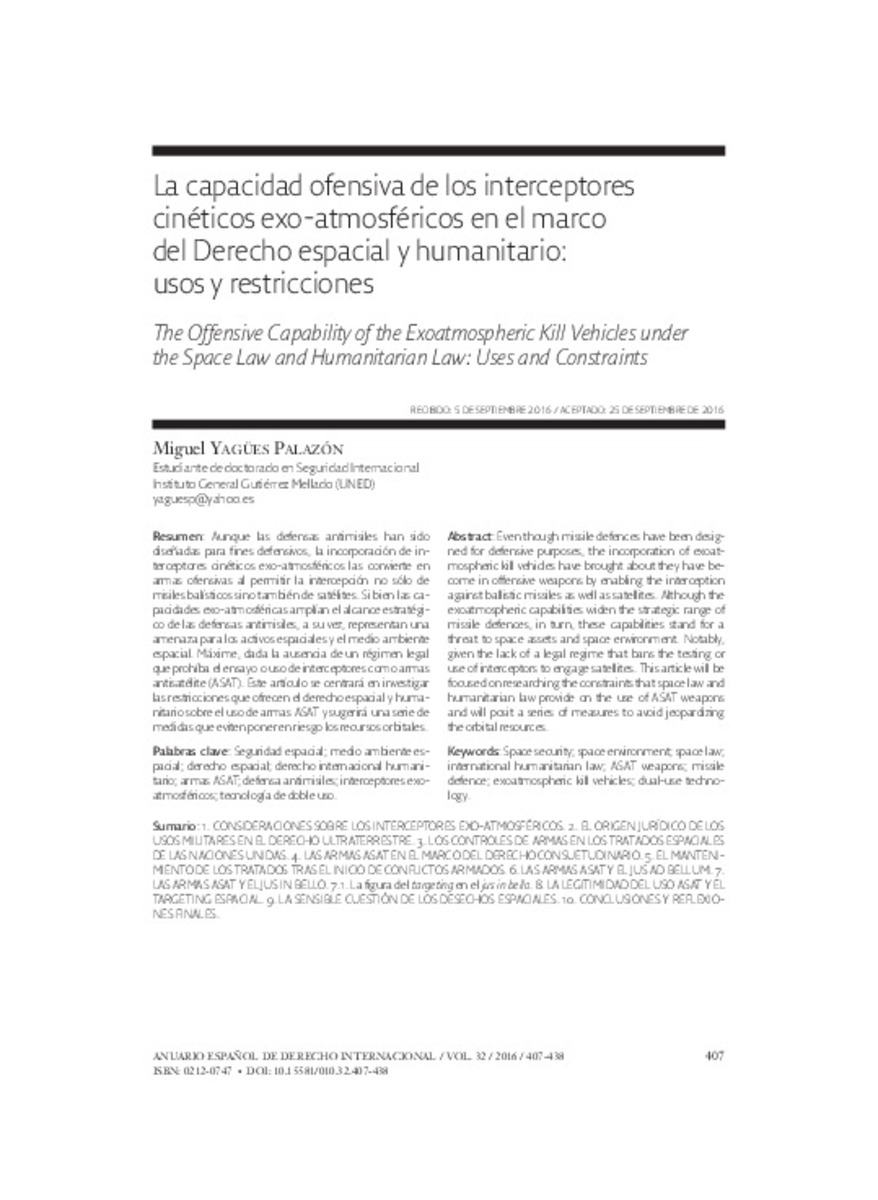Full metadata record
| DC Field | Value | Language |
|---|---|---|
| dc.creator | Yagües-Palazón, M. (Miguel) | - |
| dc.date.accessioned | 2018-01-16T08:10:28Z | - |
| dc.date.available | 2018-01-16T08:10:28Z | - |
| dc.date.issued | 2016 | - |
| dc.identifier.citation | Yagües-Palazón, M. (Miguel). "La capacidad ofensiva de los interceptores cinéticos exo-atmosféricos en el marco del Derecho espacial y humanitario: usos y restricciones". Anuario Español de Derecho Internacional. 32, 2016, 407 - 438 | es |
| dc.identifier.issn | 0212-0747 | - |
| dc.identifier.uri | https://hdl.handle.net/10171/45769 | - |
| dc.description.abstract | Aunque las defensas antimisiles han sido diseñadas para fines defensivos, la incorporación de interceptores cinéticos exo-atmosféricos las convierte en armas ofensivas al permitir la intercepción no sólo de misiles balísticos sino también de satélites. Si bien las capacidades exo-atmosféricas amplían el alcance estratégico de las defensas antimisiles, a su vez, representan una amenaza para los activos espaciales y el medio ambiente espacial. Máxime, dada la ausencia de un régimen legal que prohíba el ensayo o uso de interceptores como armas antisatélite (ASAT). Este artículo se centrará en investigar las restricciones que ofrecen el derecho espacial y humanitario sobre el uso de armas ASAT y sugerirá una serie de medidas que eviten poner en riesgo los recursos orbitales. | - |
| dc.description.abstract | Even though missile defences have been designed for defensive purposes, the incorporation of exoatmospheric kill vehicles have brought about they have become in offensive weapons by enabling the interception against ballistic missiles as well as satellites. Although the exoatmospheric capabilities widen the strategic range of missile defences, in turn, these capabilities stand for a threat to space assets and space environment. Notably, given the lack of a legal regime that bans the testing or use of interceptors to engage satellites. This article will be focused on researching the constraints that space law and humanitarian law provide on the use of ASAT weapons and will posit a series of measures to avoid jeopardizing the orbital resources. | - |
| dc.language.iso | spa | - |
| dc.publisher | Servicio de Publicaciones de la Universidad de Navarra | - |
| dc.rights | info:eu-repo/semantics/openAccess | - |
| dc.subject | Seguridad espacial | - |
| dc.subject | Medio ambiente espacial | - |
| dc.subject | Derecho espacial | - |
| dc.subject | Derecho internacional humanitario | - |
| dc.subject | Armas ASAT | - |
| dc.subject | Defensa antimisiles | - |
| dc.subject | Interceptores exo-atmosféricos | - |
| dc.subject | Tecnología de doble uso | - |
| dc.subject | Space security | - |
| dc.subject | Space environment | - |
| dc.subject | Space law | - |
| dc.subject | International humanitarian law | - |
| dc.subject | ASAT weapons | - |
| dc.subject | Missile defence | - |
| dc.subject | Exoatmospheric kill vehicles | - |
| dc.subject | Dual-use technology | - |
| dc.title | La capacidad ofensiva de los interceptores cinéticos exo-atmosféricos en el marco del Derecho espacial y humanitario: usos y restricciones | - |
| dc.title.alternative | The Offensive Capability of the Exoatmospheric Kill Vehicles under the Space Law and Humanitarian Law: Uses and Constraints | - |
| dc.type | info:eu-repo/semantics/article | - |
| dc.identifier.doi | 10.15581/010.32.407-438 | - |
| dadun.citation.endingPage | 438 | - |
| dadun.citation.publicationName | Anuario Español de Derecho Internacional | - |
| dadun.citation.startingPage | 407 | - |
| dadun.citation.volume | 32 | - |
| dc.date.updated | 2018-01-16T08:10:28Z | - |
| dc.description.version | Peer Reviewed | - |
Files in This Item:
Statistics and impact
Items in Dadun are protected by copyright, with all rights reserved, unless otherwise indicated.






